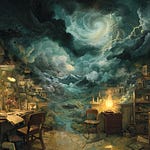A week or so ago, the selling action in the stock market had grown so bad that a number of folks thought a crash was back on the cards. It started to feel like that again this week.
But crashes are rare events. They don’t come along very often.
The 21st century has seen two so far. That’s rather a lot by the standards of the previous century, when there were perhaps five or six in the US over the course of 100 years – 1907, 1929, 1937, 1962, 1987 and 1990.
It depends how you define crash of course. You could argue there were just three.
The probability is, then, that if you forecast or expect a crash, you are going to be wrong. Even the great short sellers who made fortunes during crashes – Jesse Livermore in 1929, Stanley Druckenmiller in 2008 – will tell you that 90% of their fortunes were made on the long side, especially in growth stocks. (That’s what Druckenmiller says, at least).
Yet, a bit like ghosts and UFO landings, crashes make for good copy. Predicting crashes gets you lots of clicks and lots of followers. I think we all have an innate obsession with them. The thought of a crash and losing everything lingers at the back of every investor’s mind, the worst-case scenario.
But, as I say, selling pressure got so extreme a week or so ago that it really started to feel like a full-on crash could be on the cards. Stock markets rallied a bit, then sold off again, then rallied. The pressure might have eased, but I can tell you, I was feeling the heat, and I bet you were too.
What triggered me was a recollection of 2008, when markets had been in abject decline for some months, but the oil price kept rising. It made its way all the way to $150 a barrel, or thereabouts, in July of that year, before capitulating along with everything else by the autumn.
It occurred to me that something similar wass happening this year. Markets generally were declining, while the oil price kept on rising.
Oil price surges are driven by genuine demand, but there is always a lot of hot speculative money in there as well, which means the rises and the sell-offs can be a bit more racy than perhaps they otherwise would be.
What previous crashes can tell us about what might happen next
In any case, history often rhymes, as the saying goes, and humans will always be humans with the same psychology, and so there is some value to fractal patterns – that is, looking for similar price patterns from different periods – if you are looking to ascertain how likely certain outcomes are.
I spent some time at the weekend comparing the price action of various asset prices in the lead up to the crashes of 2000 and 2008 – the S&P 500, gold, copper, Brent crude and the long bond – compared to the price action of late.
I’m not going to post a chart as there are too many squiggly lines, and it’s confusing. But the sequence has been as follows: bonds made a high at the beginning of December 2021, then relentlessly declined. Stock markets (S&P 500) peaked at the beginning of January 2022, then relentlessly declined.
Brent, gold and copper all peaked in March, with gold and copper all going into relentless decline. Oil then had another rally and peaked in early June. Now we are having a bit of a relief rally in stocks.
So to summarise – bonds, then stocks, then precious and base metals, then oil. Then relief rally in stocks.
Turning to 2008, bonds rallied, as everything else crashed, so there is no correlation. But otherwise the sequence is similar.
Stocks peaked in October 2007, then gold and copper peaked in March 2008. Gold then fell, but copper had another rally, eventually peaking with oil in July. Then they began their fall. Stocks had a relief rally for a couple of months. Then in September we went into global free fall.
Bonds aside then, the sequence is similar enough to be concerning.
As for 2000, bonds peaked over a year ahead of stocks, declined, but then rallied as stocks fell.
Gold peaked six months ahead of stocks – which peaked in March 2000. (Gold was at the end of its worst bear market ever, so I am not even sure comparisons are valid here). But then copper and oil peaked shortly after stocks re-tested their highs in October 2000.
So leaving aside bonds, there is a definite sequence of stocks peaking, followed by base metals and oil a few months after, then the big declines.
We are following a similar sequence now.
Sentiment is so low, and markets so oversold, there is a part of me that thinks we have already seen the low. But I’m also conscious that a relief rally in stocks now, with weakness in metals and energy, is worryingly close to the 2008 crash template, and to an extent the 2000 template.
So stay defensive. Maybe not time to bet the house just yet.













